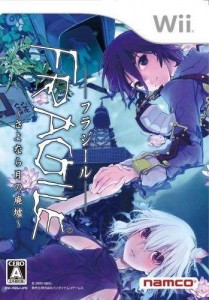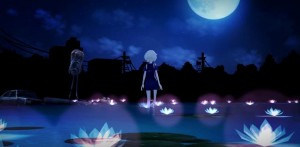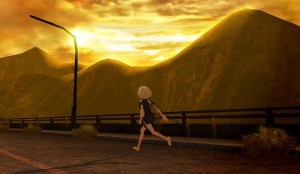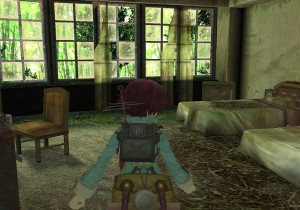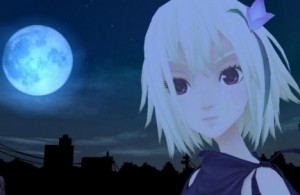Fragile Dreams: Farewell Ruins of the Moon review
System: Wii
Category: RPG
Players: 1
Developer: Namco Bandai Games/tri-Crescendo
Publisher: XSEED
Available: Now
I’m going to start this review off by telling you I have no idea how to start this review off. Why? Because Fragile is such a unique game, I’m hard pressed to review it as a “game” at all. Unfortunately, being that this is a website about games and not about whatever it is that Fragile is, I’ll have to just give it my all and hope things turn out okay.
Fragile Dreams: Farewell Ruins of the Moon is classified as a role playing game, and it follows the tale of a young 15 year old boy named Seto who finds himself alone in the world after his “grandfather” (whether it actually was his grandfather or just an old man he was living with remains to be seen) passes away during the summer. As such, he is left to explore the ruined world and look for survivors on his own with no information as to what happened that left everyone dead except for him. Shortly thereafter, he runs into a girl (a mysterious girl, at that) and decides he better follow her if he wants to be not-lonely for the rest of his life. Thus begins the solemn tale of Fragile Dreams.
Now, I said that the game was classified as an RPG, but it really only is in the loosest sense. There is a leveling up system, and technically you also have stats that you can pay attention to, but they really don’t affect the outcome of your battles. There isn’t armor to equip and modify your defense, there isn’t really a speed stat, and the only two stats that really matter are HP and Attack. Even these two, however, are simplified to a point where you don’t even have to look at them. Depending on the weapon you have equipped, you will do a set amount of damage – with no variance at all – and you will always take a certain amount of damage from each enemy. There is no chance involved, there are no critical hits, there’s no battle screen, and you can’t do more than one type of attack with each weapon. Literally, it’s an RPG stripped as far down as possible with still being allowed to be called an RPG. Is this a bad thing? Not necessarily, but it depends on your mindset going into the game.
If you’ve read any other reviews about Fragile, you’ve probably read the phrase “This is not a game for everyone” about a thousand times, and that really couldn’t be more right. The game is filled with things that would turn many gamers off outright, such as the enormous amount of walking that is done in the game. There are a few corridors that are straight paths with enemies every so often that literally take ten minutes to get from one end to the other of. Often times the developers copy/paste textures and environmental objects, so you really almost lose all sense of time and direction while traversing them. Is this a good thing? Well, yes and no. It adds to the atmosphere and sense of timelessness in the game, but it’s definitely a bad thing for the gameplay.
The flashlight controls of the game are also a bit frustrating. Most of the movement is controlled with the control stick, but like many Wii games, turning is controlled via the pointer. While this works for the most part, there were a number of times where I’d try and turn, but rather than turning in the direction I want, Seto would spin around towards the screen because I had accidentally pointed towards a set piece that was very close to the screen, and in turn, Seto also went to face that object. This was something that could have very easily been fixed, and since it wasn’t, it went on to mar an otherwise well-controlled game.
Most of the experience of Fragile is set around walking around and collecting items, with little actual gameplay to be found, which really doesn’t matter much because in a game like Fragile all that the gameplay needed to do was back off. Like I said earlier, as a game, Fragile isn’t all that good because the gameplay is simple and buggy. Combat isn’t necessarily bad, and movement isn’t either; both are just very basic and simplify a game which could have benefited from an almost Zelda-like combat mechanic. Fortunately, absolutely everything else in the game was crafted with utmost care, and turned out fantastically, beginning with the soundtrack.
The soundtrack to Fragile Dreams is, to put it bluntly, one of the best soundtracks I have heard in a very long time. The entire score is filled with hauntingly beautiful piano melodies that I cannot get enough of, and I’ve had the soundtrack for nearly a year now. If you don’t have the desire to play the game, at least do yourself a favor and pick of the soundtrack, because you won’t regret it. One thing that makes its usage in the game better is the fact that it almost never plays while you’re walking around, with the only two exceptions being enemy/boss fights and the lead-up to the final boss. The only other time you hear it is in the various cutscenes scattered about, and there are many.
Aside from the music, all other sound design in the game is fantastic as well. I personally played the game with the Japanese voice acting and English subtitles, for fear that my acclimation to the Japanese voices would bias me against English dubs, and I can’t say I regret the decision. Voice actors were spot on with emotion and timing, so it seemed, and all other sound effects in the game (chiefly the eerie wind and other ambient noises) did wonders for keeping the atmosphere top-notch throughout.
Graphically, the game manages to surpass almost all third party Wii offerings, both technically and artistically, by providing an almost ethereal spin on the classic anime style. As far as feel, the game is separated into two clear sections: Above ground and below ground. The below-ground segments are dark, dim, and riddled with long corridors and huge metal rooms, stuck with generators, fans, and other sorts of machinery, while the above-ground segments are often filled with some of my favorite artistic scenery in gaming. The skylines are always massive and colorful, filled with a huge moon, stars, and clouds that are otherworldly in nature and, if you’re the right kind of player, could have you simply staring for hours. Some points were so breathtaking that I found myself going nearly 40 minutes out of my way simply to take a path that would lead me through the location again. I’ll do my best to avoid spoilers, but for those who have played the game, the place I refer to involved a roller coaster.
Of course, a game with a great atmosphere can’t survive on that alone. It needs at least a great story to help propel the player forward into the world of the game, and fortunately, Fragile has plenty of great story. Again trying to avoid spoilers, I can say that more so than possibly any other game I’ve had the pleasure of playing, Fragile’s story makes you think. It makes your mind wander to subjects like friends, family, life, mortality, what it means to be human, and the legacy that humanity has left on this earth; and most of it if pretty grim. During the game, you will connect with the characters, all of which are brimming with personality, and you’ll relate to their plight on a very deep level. As Seto travels the broken shattered world void of humanity, he finds relics of humans who no longer live. These little trinkets allow Seto to “play” parts of their owners lives, and subsequently get a glimpse into what life was like for people before whatever it was that wiped humans out happened. They do a great job of reinforcing the melancholic nature of the game, and always keep the happiness of the player in check. As far as story and forming a connection to the world of a game, it rarely gets any better than Fragile.
The bottom line about Fragile is that it’s a game that will be hard for some people to fall for, but if you do end up falling for it you’re in for an amazing experience. Rarely in a game – nor a movie or book for that matter – have I felt the way I feel about Fragile, and in that sense I cannot be more grateful of Tri-crescendo for making it. Without a doubt there are issues with the game that cannot be overlooked, namely the clunky controls and simple combat, but when all is said and done you cannot find something like Fragile on any other system, past or present. Taking that into account, I highly recommend Fragile to anyone who has even fleeting interest in the premise of the game– just make sure you go into it with an very open mind.
Case in point:
-Buy Fragile if you like deep stories, character attachments, thoughtfulness, and fantastic atmosphere in your games.
-Don’t buy Fragile if you’re looking for complex gameplay and an action-packed story.
